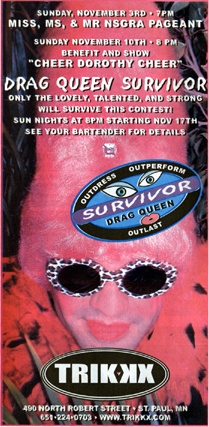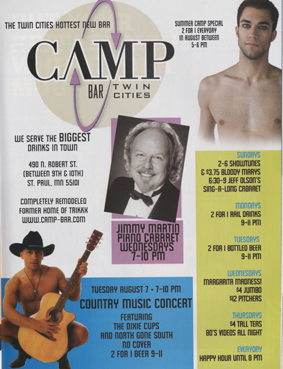Difference between revisions of "Camp Bar"
| Line 20: | Line 20: | ||
| − | Gay and bisexual men first frequented the [[Golden Rule/Emporium Department Stores]] and the [[Bremer Arcade]] at Robert Street and 7th. gay activity relocated just two blocks to the northwest when the department stores closed in the late 1970s and cruising took on a public visibility. The Rossmor has witnessed considerable change as well; beginning as a bohemian artist commune, it underwent a renovation and is now the home to scores of upscale condominium lofts. | + | Gay and bisexual men first frequented the [[The Golden Rule/Emporium Department Stores]] and the [[Bremer Arcade]] at Robert Street and 7th. gay activity relocated just two blocks to the northwest when the department stores closed in the late 1970s and cruising took on a public visibility. The Rossmor has witnessed considerable change as well; beginning as a bohemian artist commune, it underwent a controversial renovation and is now the home to scores of upscale condominium lofts.<small>(1)</small> |
| − | The space formerly occupied by Trixx “quietly” changed to camp in 2007. It is indicative of the changing tastes in Minnesota’s queer community—gone is the era when a dance floor, liquor, and mere gay ownership was sufficient to keep a queer night spot afloat. Instead, bar owners must attract their patrons with cutting-edge décor, “handcrafted drinks,” and plush VIP lounges—the [[Brass Rail Bar]] and Happy Hour (part of the [[Gay 90s Complex]]) underwent similar renovations in the late 2000s. | + | The space formerly occupied by Trixx “quietly” changed to camp in 2007.<small>(2)</small> It is indicative of the changing tastes in Minnesota’s queer community—gone is the era when a dance floor, liquor, and mere gay ownership was sufficient to keep a queer night spot afloat. Instead, bar owners must attract their patrons with cutting-edge décor, “handcrafted drinks,” and plush VIP lounges—the [[Brass Rail Bar]] and Happy Hour (part of the [[Gay 90s Complex]]) underwent similar renovations in the late 2000s. |
|} | |} | ||
{| {{prettytable}} | {| {{prettytable}} | ||
| Line 36: | Line 36: | ||
| − | For, and at one time, queer men were victims of self-hatred, as they considered themselves mentally ill or sinful; in the 1970s, 80s, and early 90s, gay men adopted a hyper-masculine style to prove that they were “real men;” presently, some queer people have adopted self-perceptions as urban arbiters of style and taste. | + | For, and at one time, queer men were victims of self-hatred, as they considered themselves mentally ill or sinful;<small>(3)</small> in the 1970s, 80s, and early 90s, gay men adopted a hyper-masculine style to prove that they were “real men;”<small>(4)</small> presently, some queer people have adopted self-perceptions as urban arbiters of style and taste. |
| − | Changes aside, Camp adopts an unassuming demeanor. In a youtube video on the Camp website, owner Bill Collins says “Promise you you’re gonna have a really good time. And don’t you really need a drink or something to eat anyway?” | + | Changes aside, Camp adopts an unassuming demeanor. In a youtube video on the Camp website, owner Bill Collins says “Promise you you’re gonna have a really good time. And don’t you really need a drink or something to eat anyway?”<small>(5)</small> |
| <div style="text-align: center;"> | | <div style="text-align: center;"> | ||
[[Image:Svc_camp.jpg]] | [[Image:Svc_camp.jpg]] | ||
| Line 53: | Line 53: | ||
| − | (1) "Take Back the Nightlife: The GLBT Bar scene is Experiencing a Renaissance -Just in Time for Pride." The Minneapolis Star-Tribune, special "PRIDE 2007" Issue. 6/21/2007 | + | |
| + | <small>(1)</small> Gihring, Tim. "Crawl Spaces: The Art of Doing the St. Paul Art Crawl." ''Minnesota Monthly,'' April 2007. | ||
| + | |||
| + | <small>(2)</small> "Take Back the Nightlife: The GLBT Bar scene is Experiencing a Renaissance -Just in Time for Pride." The Minneapolis Star-Tribune, special "PRIDE 2007" Issue. 6/21/2007 | ||
| + | |||
| + | <small>(3)</small> Russell, Paul. ''The Gay 100: A Ranking of the Most Influential Gay Men and Lesbians, Past and Present.'' New York: Kensington Books, 2002. Page xvii. | ||
| + | |||
| + | <small>(4)</small> Patterson, Eric. ''On Brokeback Mountain: Meditations About Masculinity, Fear, and Love in the story and the Film.'' Maryland: Lexington Books, 2008. Page 62. | ||
| + | |||
| + | <small>(5)</small> http://www.camp-bar.net/about | ||
This page is still under construction. -SVC | This page is still under construction. -SVC | ||
Part of [[Minneapolis/St. Paul, MN: 100 Queer Places in Minnesota History, (1860-1969), (1969-2010)]] | Part of [[Minneapolis/St. Paul, MN: 100 Queer Places in Minnesota History, (1860-1969), (1969-2010)]] | ||
Revision as of 19:52, 21 March 2010
490 N Robert St, St Paul, MN
| Trixx Bar Advertisement. From Lavender Magazine, 2002 |
Gay bars use the Rossmor Building in downtown St. Paul like a revolving door—The Grand Finale, Rumours and Innuendo, Club Vogue, Rocky’s on 10th, and Trixx compose an almost-continuous list of queer use in the building since 1977. A former shoe factory, the structure’s attraction may be the result of queer migration.
|
| In part, these changes accompany an evolving self-perception of gay and bisexual men.
|
Camp advertisement in Lavender Magazine, shortly after opening in 2007. |
(1) Gihring, Tim. "Crawl Spaces: The Art of Doing the St. Paul Art Crawl." Minnesota Monthly, April 2007.
(2) "Take Back the Nightlife: The GLBT Bar scene is Experiencing a Renaissance -Just in Time for Pride." The Minneapolis Star-Tribune, special "PRIDE 2007" Issue. 6/21/2007
(3) Russell, Paul. The Gay 100: A Ranking of the Most Influential Gay Men and Lesbians, Past and Present. New York: Kensington Books, 2002. Page xvii.
(4) Patterson, Eric. On Brokeback Mountain: Meditations About Masculinity, Fear, and Love in the story and the Film. Maryland: Lexington Books, 2008. Page 62.
(5) http://www.camp-bar.net/about
This page is still under construction. -SVC
Part of Minneapolis/St. Paul, MN: 100 Queer Places in Minnesota History, (1860-1969), (1969-2010)

